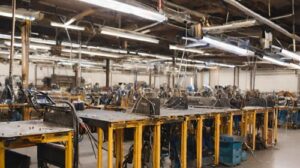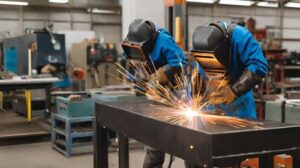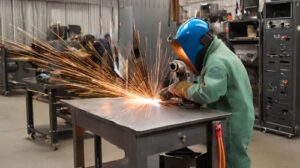Table of Contents
Discover the untapped goldmine. Where is welding in high demand? Brace yourself for an eye-opening journey into the hottest spots for welders. Unveil the secrets behind skyrocketing demand and unlock your path to career success. Discover where opportunity knocks loudest for aspiring welders. Don’t miss out on the untapped gold mine of career success!
1. Regional Demand for Welders
In the landscape of welding careers, geographical location plays a pivotal role in determining job availability and demand. Let’s delve into the states that stand out for their substantial need for skilled welders.
Geographical Regions with High Demand
- North America
North America, particularly the United States and Canada, showcases a significant demand for welders due to robust manufacturing and infrastructure development.
- Europe
European countries like Germany and the UK are prominent in welding demand, driven by their strong manufacturing and construction sectors.
- Asia-Pacific
Countries like China, India, and Japan exhibit substantial demand owing to rapid industrialization and infrastructure expansion.
- Emerging Markets
Regions in South America and Africa are experiencing a burgeoning need for welding services with their increasing industrialization.
2. Welder Salary Variations Across States
Understanding the monetary aspects of a welding career is essential. The salary discrepancies for welders across different states can significantly impact career choices and financial stability. Let’s delve into the variations in welder salaries across the United States.
- Factors Influencing Salary Variances:
Several factors contribute to the differences in welder salaries from state to state. Cost of living, demand-supply dynamics, regional industries, and unionization can all play pivotal roles in determining the wages of welders.
- High-Paying States for Welders:
States like Alaska, Hawaii, California, and Washington often stand out as high-paying regions for welders. The demand in these areas, particularly in specialized industries like aerospace and shipbuilding, drives up the wages for skilled welders.
- Mid-Range Salary States:
States such as Texas, Louisiana, and Ohio offer moderate yet competitive wages for welders. The presence of thriving industries like oil and gas, manufacturing, and automotive keeps the demand steady, reflecting in decent compensation for welding professionals.
- Low-Paying States for Welders:
On the contrary, some states offer comparatively lower wages for welders. States in the Midwest or regions with limited industrial diversification might present lower salaries due to lesser demand or a more competitive job market.
- Unionized Environments and Salary Standards:
Unionization also plays a significant role in defining wage standards for welders. States with stronger union presence tend to have more standardized and often higher wages compared to non-unionized areas.
- Negotiation and Specializations:
Welder salaries can also vary based on negotiation skills and specialized expertise. Welders with certifications in specialized welding techniques or experience in high-demand industries often command higher salaries irrespective of the state.
3. Top States for Lucrative Welding Careers
For welders seeking not just employment but lucrative career prospects, certain states offer exceptional opportunities for financial growth and professional advancement. Let’s explore the regions where welders can expect to find the most rewarding careers in terms of income and career growth.
- Alaska: Alaska emerges as a top contender for welders seeking high-paying opportunities. Industries like oil and gas, maritime, and construction often offer competitive salaries, compensating for the challenging working conditions and remote locations.
- Hawaii: Similar to Alaska, Hawaii stands out as a state with a high cost of living but also higher wages for welders due to its demand in maritime-related welding for shipbuilding and repairs.
- California: With a diverse industrial landscape encompassing aerospace, manufacturing, and construction, California remains a hotspot for welders seeking well-paying jobs. Cities like Los Angeles and San Francisco often boast higher salaries owing to the demand from various industries.
- Washington: Washington state, particularly in cities like Seattle, offers robust opportunities in aerospace, shipbuilding, and manufacturing. Skilled welders in these sectors often command impressive salaries.
- Texas: While Texas might not top the list for the highest welder salaries, its vast industrial landscape and demand in oil, gas, and manufacturing industries make it a consistent player in offering steady and competitive wages for welders.
- Factors Defining Lucrative Opportunities: Several common factors contribute to these states’ attractiveness for welders. These include the presence of booming industries, specialized demands for welding skills, high demand for shipbuilding or aerospace projects, and a need for infrastructure development and repair.
4. Least Paying States for Welders
While some states offer lucrative opportunities for welders, others might present comparatively lower wages, impacting career choices and financial stability. Exploring the states where welders earn lower salaries provides insights into regions where compensation might be less competitive.
- Midwest States: Several states in the Midwest, such as Kansas, Iowa, and Nebraska, often offer lower wages for welders. The predominance of agricultural economies and fewer specialized industrial demands could contribute to the relatively lower salaries in these regions.
- Southern States: Due to a number of variables, such as a less varied industrial environment and a lower cost of living, some southern states, such as Mississippi, Alabama, and Arkansas, may also offer lower earnings for welders.
- variables Affecting Lower earnings: A number of variables are responsible for these states’ lower earnings. Welders may see a decrease in pay due to a lack of industrial diversity, a decline in the need for welders, and decreased competition for open positions.
- Regional Cost of Living: The regional cost of living is another element that affects salaries.
. States with lower living expenses might compensate welders accordingly, which might not align with the wages offered in higher cost-of-living states.
- Strategies for Compensation Optimization: Welders in these states might consider strategies such as pursuing specialized certifications, expanding skill sets to meet niche demands, or exploring opportunities in adjacent states with higher-paying job markets.
5. Hotspots for Welding Jobs
Certain cities and regions stand out as hotspots for welding jobs, offering a concentration of opportunities and diverse industries requiring welding expertise. Exploring these areas provides insight into where welders can find abundant job prospects and potentially favorable work environments.
- Houston, Texas: Houston consistently emerges as a hotspot for welding jobs due to its robust oil and gas industry. Because of the city’s position in manufacturing and energy generation, there is a constant need for qualified welders in a variety of industries.
- Los Angeles, California: Los Angeles provides a variety of welding prospects due to its status as a centre for aerospace, manufacturing, and construction. The demand for welders in specialized fields within these industries contributes to the city’s attractiveness for welding careers.
- Seattle, Washington: Seattle’s thriving aerospace and maritime industries make it a sought-after destination for welders. Shipbuilding, aircraft manufacturing, and technological advancements drive the need for skilled welding professionals.
- Detroit, Michigan: Known for its automotive industry, Detroit presents numerous welding opportunities in vehicle manufacturing and related sectors. The city’s historical association with automotive production keeps the demand for welders consistently high.
- Factors Defining Hotspots: Common factors contributing to these cities’ status as welding hotspots include the presence of specialized industries, ongoing infrastructure development, repair and maintenance needs, and a diverse range of job opportunities.
- Emerging Centers: Additionally, emerging centers like Charlotte, North Carolina, and Denver, Colorado, are gaining traction as welding hotspots due to their growing manufacturing sectors, infrastructure projects, and technological advancements.
6. In-Demand Welding Specializations
- Within the welding profession, certain specializations are more sought after than others due to their relevance in specific industries or unique skill requirements. Understanding these in-demand welding specializations provides insight into where welders can focus their expertise for optimal job opportunities.
- Underwater Welding: Underwater welding remains a highly specialized field, primarily used in maritime industries for ship repair and offshore structures. Locations near coastal areas or ports often require underwater welders due to their expertise in welding in challenging aquatic environments.
- Aerospace Welding: Aerospace welding involves high precision and quality standards for aircraft manufacturing and maintenance. Regions with prominent aerospace industries, like Seattle and Los Angeles, often demand welders skilled in this specialized field.
- Pipeline Welding: States with extensive oil and gas operations, such as Texas, Louisiana, and Alaska, have a consistent demand for pipeline welders. Their expertise in welding pipelines is crucial for the energy sector’s infrastructure. shaping
- Structural Steel Welding: Construction and infrastructure development rely heavily on structural steel welding. Cities with ongoing construction projects, like New York and Chicago, seek welders proficient in this specialization.
- Robotics and Automation Welding: As industries increasingly embrace automation, welders skilled in robotics and automation welding find opportunities in manufacturing hubs aiming for technological advancements.
7. Forecasted Demand Trends in 2023
Predicting the future demand for welding professionals involves analyzing current trends, industry projections, and technological advancements the job market. Understanding the forecasted demand trends for 2023 provides insight into where the field of welding is heading and the potential opportunities it may offer.
- Technological Advancements: The integration of robotics, automation, and advanced welding technologies continues to reshape the welding landscape. Welders proficient in these technological advancements are likely to see increased demand, particularly in industries adopting these innovations.
- Infrastructure Projects: Ongoing and planned infrastructure projects, such as bridges, roads, and buildings, contribute to the demand for welders. States with ambitious infrastructure plans are expected to require skilled welding professionals to support these projects.
- Energy Sector Dynamics: The energy sector, especially the oil and gas industry, significantly influences welding demand. Regions with expanding oil exploration, renewable energy projects, and pipeline developments are likely to sustain or increase the demand for welders.
- Aerospace and Manufacturing Growth: The aerospace and manufacturing sectors are anticipated to witness steady growth. States housing aerospace manufacturing hubs or witnessing industrial expansion are expected to seek skilled welders for various specialized roles.
- Green Initiatives and Sustainable Practices: With a growing emphasis on sustainability, welders adept at green technologies, such as eco-friendly welding methods and materials, might find increased demand in industries prioritizing environmental considerations.
8. Favorable Work Environments for Welders
Beyond high demand and competitive salaries, the work environment significantly impacts a welder’s job satisfaction and overall career experience. Exploring states or regions that offer favorable work environments for welders involves considering factors like job availability, workplace conditions, and quality of life.
- Safety Standards: States with stringent safety regulations and a commitment to maintaining safe working environments are favorable for welders. These regions prioritize worker safety, reducing occupational hazards and ensuring a conducive workplace.
- Job Availability and Stability: Favorable work environments often include regions with a stable job market for welders. Areas with consistent demand, diverse industries, and a steady influx of job opportunities contribute to a sense of job security and stability.
- Union Presence and Benefits: States with strong union presence often offer welders standardized wages, benefits, and job protections. Unionized environments can provide additional support, negotiation power, and better working conditions for welders.
- Quality of Life Factors: Considering factors like cost of living, access to amenities, healthcare facilities, educational opportunities, and recreational activities is crucial. States offering a higher quality of life contribute to overall job satisfaction for welders and their families.
- Work-Life Balance Considerations: Regions promoting a healthy work-life balance through reasonable working hours, flexible schedules, and supportive workplace policies can significantly impact a welder’s satisfaction and well-being.
9. Optimal Cities for Welding Careers
While states provide a broad view of welding job opportunities, exploring specific cities renowned for their thriving welding industries and conducive work environments can offer valuable insights for welders seeking optimal career destinations.
- Houston, Texas: Renowned for its oil and gas industry, Houston offers abundant opportunities for welders. The city’s diverse industrial landscape, coupled with numerous manufacturing and energy projects, creates a consistent demand for skilled welding professionals.
- Los Angeles, California: Los Angeles stands out for its aerospace, construction, and manufacturing sectors, providing diverse opportunities for welders. The city’s technological advancements and specialized demands within these industries make it an attractive destination.
- Seattle, Washington: Seattle’s prominence in aerospace and maritime industries fosters a robust demand for welders. Shipbuilding, aircraft manufacturing, and technological innovation make it a prime location for skilled welding careers.
- Detroit, Michigan: Famous for its automotive industry, Detroit remains a hub for welding opportunities in vehicle manufacturing and related sectors. The city’s historical ties to automotive production sustain a consistent demand for welders.
- Charlotte, North Carolina: Charlotte is emerging as a center for manufacturing and technological advancements, creating a growing demand for skilled welders. The city’s focus on innovation and infrastructure development presents promising career prospects.
- Factors Defining Optimal Cities: Common factors contributing to these cities’ appeal for welding careers include the presence of specialized industries, ongoing infrastructure projects, job stability, union presence, and a favorable work-life balance.
10. Overview of the Majority of Welding Jobs
Understanding the distribution and concentration of welding jobs across various regions provides a comprehensive overview of where the majority of opportunities lie within the United States. Exploring the geographical distribution of welding jobs sheds light on the regions where welders can find plentiful employment prospects.
- Industrial Belt Regions: The industrial belt regions encompass states like Texas, California, Ohio, and Michigan, among others. These areas host a significant portion of welding jobs due to their diverse manufacturing sectors, automotive industries, and infrastructure projects.
- Coastal Areas and Ports: Coastal areas and regions with prominent ports, such as Florida, Washington, and California, often require welders skilled in marine welding for shipbuilding, repair, and offshore structures.
- Oil and Gas Centres: States like Texas, Louisiana, and Alaska, which have a significant oil and gas business, provide a wealth of welding prospects for pipeline building, maintenance, and related operations.
- Emerging Industrial Centres: As a result of their expanding manufacturing sectors, infrastructure improvements, and technology developments, cities like Charlotte, Denver, and Seattle are becoming hotspots for welding jobs.
- Factors Influencing Job Concentration: Factors like industry diversification, ongoing infrastructure developments, demand in specialized sectors, and geographical advantages significantly influence the concentration of welding jobs in specific regions.
Conclusion
In conclusion, the quest to uncover where welding is in high demand reveals a diverse landscape ripe with opportunities. From bustling cities to emerging industrial hubs, this exploration highlights the thriving markets where welders find ample career prospects.
Understanding these hotspots and specialized fields provides the key to unlocking a successful welding career. Embracing this knowledge equips welders to navigate the professional terrain, leveraging demand and maximizing their potential for growth and success in this dynamic field.
FAQs: Where is welding in high demand?
Are welding jobs in high demand globally?
Yes, welding jobs are in demand globally, with varying degrees across different regions.
What qualifications are required for a welding career?
Vocational training and certifications in welding are crucial for career advancement.
How can one keep up with the evolving welding industry?
Continuous learning and staying updated with technological advancements are essential.
Is welding a sustainable career choice?
Yes, welding offers stable career prospects with opportunities for growth and specialization.
What role does automation play in the future of welding?
Automation is reshaping welding processes, emphasizing the need for advanced skills in technology integration.





4 thoughts on “Where Is Welding in High Demand? Explore Top Markets!”